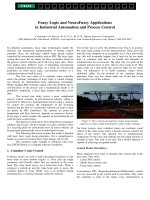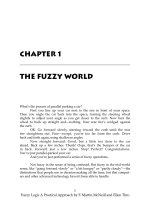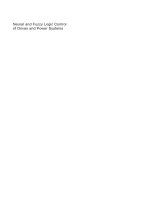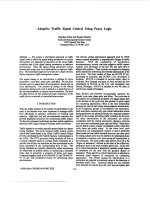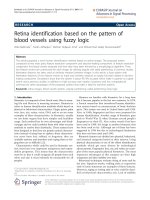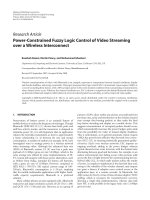Fuzzy logic with engineering applicaiton
Bạn đang xem bản rút gọn của tài liệu. Xem và tải ngay bản đầy đủ của tài liệu tại đây (5.43 MB, 652 trang )
This page intentionally left blank
FUZZY LOGIC WITH
ENGINEERING
APPLICATIONS
Second Edition
This page intentionally left blank
FUZZY LOGIC WITH
ENGINEERING
APPLICATIONS
Second Edition
Timothy J. Ross
University of New Mexico, USA
Copyright 2004
John Wiley & Sons Ltd, The Atrium, Southern Gate, Chichester,
West Sussex PO19 8SQ, England
Telephone (+44) 1243 779777
Email (for orders and customer service enquiries):
Visit our Home Page on www.wileyeurope.com or www.wiley.com
All Rights Reserved. No part of this publication may be reproduced, stored in a retrieval system or
transmitted in any form or by any means, electronic, mechanical, photocopying, recording, scanning or
otherwise, except under the terms of the Copyright, Designs and Patents Act 1988 or under the terms of a
licence issued by the Copyright Licensing Agency Ltd, 90 Tottenham Court Road, London W1T 4LP,
UK, without the permission in writing of the Publisher. Requests to the Publisher should be addressed to
the Permissions Department, John Wiley & Sons Ltd, The Atrium, Southern Gate, Chichester, West
Sussex PO19 8SQ, England, or emailed to , or faxed to (+44) 1243 770620.
This publication is designed to provide accurate and authoritative information in regard to the subject
matter covered. It is sold on the understanding that the Publisher is not engaged in rendering professional
services. If professional advice or other expert assistance is required, the services of a competent
professional should be sought.
Other Wiley Editorial Offices
John Wiley & Sons Inc., 111 River Street, Hoboken, NJ 07030, USA
Jossey-Bass, 989 Market Street, San Francisco, CA 94103-1741, USA
Wiley-VCH Verlag GmbH, Boschstr. 12, D-69469 Weinheim, Germany
John Wiley & Sons Australia Ltd, 33 Park Road, Milton, Queensland 4064, Australia
John Wiley & Sons (Asia) Pte Ltd, 2 Clementi Loop #02-01, Jin Xing Distripark, Singapore 129809
John Wiley & Sons Canada Ltd, 22 Worcester Road, Etobicoke, Ontario, Canada M9W 1L1
Wiley also publishes its books in a variety of electronic formats. Some content that appears
in print may not be available in electronic books.
British Library Cataloguing in Publication Data
A catalogue record for this book is available from the British Library
ISBN 0-470-86074-X (Cloth)
0-470-86075-8 (Paper)
Typeset in 10/12pt Times NewRoman by Laserwords Private Limited, Chennai, India
Printed and bound in Great Britain by TJ International, Padstow, Cornwall
This book is printed on acid-free paper responsibly manufactured from sustainable forestry
in which at least two trees are planted for each one used for paper production.
This book is dedicated to the memories of my father, Jack,
and my sister, Tina – the two behavioral bookends of my life.
This page intentionally left blank
CONTENTS
About the Author
Preface to the Second Edition
1 Introduction
The Case for Imprecision
An Historical Perspective
The Utility of Fuzzy Systems
Limitations of Fuzzy Systems
The Allusion: Statistics and Random Processes
Uncertainty and Information
Fuzzy Sets and Membership
Chance versus Fuzziness
Sets as Points in Hypercubes
Summary
References
Problems
2 Classical Sets and Fuzzy Sets
Classical Sets
Operations on Classical Sets
Properties of Classical (Crisp) Sets
Mapping of Classical Sets to Functions
Fuzzy Sets
Fuzzy Set Operations
Properties of Fuzzy Sets
Noninteractive Fuzzy Sets
Alternative Fuzzy Set Operations
Summary
References
Problems
xiii
xv
1
2
3
6
8
10
12
13
15
17
19
19
20
24
25
27
28
32
34
35
36
41
42
43
43
44
viii
CONTENTS
3 Classical Relations and Fuzzy Relations
Cartesian Product
Crisp Relations
Cardinality of Crisp Relations
Operations on Crisp Relations
Properties of Crisp Relations
Composition
Fuzzy Relations
Cardinality of Fuzzy Relations
Operations on Fuzzy Relations
Properties of Fuzzy Relations
Fuzzy Cartesian Product and Composition
Tolerance and Equivalence Relations
Crisp Equivalence Relation
Crisp Tolerance Relation
Fuzzy Tolerance and Equivalence Relations
Value Assignments
Cosine Amplitude
Max–Min Method
Other Similarity Methods
Other Forms of the Composition Operation
Summary
References
Problems
General Relations
Value Assignments and Similarity
Equivalence Relations
Other Composition Operations
4 Properties of Membership Functions, Fuzzification, and
Defuzzification
Features of the Membership Function
Various Forms
Fuzzification
Defuzzification to Crisp Sets
λ-cuts for Fuzzy Relations
Defuzzification to Scalars
Summary
References
Problems
5 Logic and Fuzzy Systems
Part I Logic
Classical Logic
Tautologies
Contradictions
Equivalence
52
53
53
55
56
56
57
58
59
59
59
59
66
66
67
68
71
72
74
74
74
75
75
76
76
85
88
88
90
91
93
94
96
98
99
112
113
114
120
120
121
126
128
128
CONTENTS
Exclusive Or and Exclusive Nor
Logical Proofs
Deductive Inferences
Fuzzy Logic
Approximate Reasoning
Other Forms of the Implication Operation
Part II Fuzzy Systems
Natural Language
Linguistic Hedges
Fuzzy (Rule-Based) Systems
Graphical Techniques of Inference
Summary
References
Problems
6 Development of Membership Functions
Membership Value Assignments
Intuition
Inference
Rank Ordering
Neural Networks
Genetic Algorithms
Inductive Reasoning
Summary
References
Problems
7 Automated Methods for Fuzzy Systems
Definitions
Batch Least Squares Algorithm
Recursive Least Squares Algorithm
Gradient Method
Clustering Method
Learning From Example
Modified Learning From Example
Summary
References
Problems
8 Fuzzy Systems Simulation
Fuzzy Relational Equations
Nonlinear Simulation Using Fuzzy Systems
Fuzzy Associative Memories (FAMs)
Summary
References
Problems
ix
129
130
132
134
137
141
142
143
145
148
151
162
163
165
178
179
179
180
181
182
193
200
206
208
209
212
213
216
220
223
228
231
234
242
243
243
245
250
251
254
264
265
265
x
CONTENTS
9 Rule-base Reduction Methods
Fuzzy Systems Theory and Rule Reduction
New Methods
Singular Value Decomposition
Combs Method
SVD and Combs Method Examples
Summary
References
Problems
Singular Value Decomposition
Combs Method for Rapid Inference
10 Decision Making with Fuzzy Information
Fuzzy Synthetic Evaluation
Fuzzy Ordering
Nontransitive Ranking
Preference and Consensus
Multiobjective Decision Making
Fuzzy Bayesian Decision Method
Decision Making under Fuzzy States and Fuzzy Actions
Summary
References
Problems
Ordering and Synthetic Evaluation
Nontransitive Ranking
Fuzzy Preference and Consensus
Multiobjective Decision Making
Bayesian Decision Making
11 Fuzzy Classification and Pattern Recognition
Part I Classification
Classification by Equivalence Relations
Crisp Relations
Fuzzy Relations
Cluster Analysis
Cluster Validity
c-Means Clustering
Hard c-Means (HCM)
Fuzzy c-Means (FCM)
Fuzzy c-Means Algorithm
Classification Metric
Hardening the Fuzzy c-Partition
Similarity Relations from Clustering
Part II Pattern Recognition
Feature Analysis
Partitions of the Feature Space
274
275
275
276
282
284
303
304
304
304
306
308
310
312
315
317
320
326
335
349
350
350
350
352
353
355
357
362
362
363
363
365
369
370
370
371
379
382
387
389
391
392
393
393
CONTENTS
Single-Sample Identification
Multifeature Pattern Recognition
Image Processing
Syntactic Recognition
Formal Grammar
Fuzzy Grammar and Syntactic Recognition
Summary
References
Problems
Exercises for Equivalence Classification
Exercises for Fuzzy c-Means
Exercises for Classification Metric and Similarity
Exercises for Fuzzy Vectors
Exercises for Multifeature Pattern Recognition
Exercises for Syntactic Pattern Recognition
Exercises for Image Processing
12 Fuzzy Arithmetic and the Extension Principle
Extension Principle
Crisp Functions, Mapping, and Relations
Functions of Fuzzy Sets – Extension Principle
Fuzzy Transform (Mapping)
Practical Considerations
Fuzzy Arithmetic
Interval Analysis in Arithmetic
Approximate Methods of Extension
Vertex Method
DSW Algorithm
Restricted DSW Algorithm
Comparisons
Summary
References
Problems
13 Fuzzy Control Systems
Control System Design Problem
Control (Decision) Surface
Assumptions in a Fuzzy Control System Design
Simple Fuzzy Logic Controllers
Examples of Fuzzy Control System Design
Aircraft Landing Control Problem
Fuzzy Engineering Process Control [Parkinson, 2001]
Classical Feedback Control
Classical PID Control
Fuzzy Control
Multi-input, Multi-output (MIMO) Control Systems
Fuzzy Statistical Process Control
xi
394
400
412
420
422
424
429
429
430
430
431
434
435
436
444
444
445
445
446
447
448
450
455
457
459
459
462
465
466
469
469
470
476
478
479
480
480
481
485
492
492
494
496
500
504
xii
CONTENTS
Measurement Data – Traditional SPC
Attribute Data – Traditional SPC
Industrial Applications
Summary
References
Problems
14 Miscellaneous Topics
Fuzzy Optimization
One-dimensional Optimization
Fuzzy Cognitive Mapping
Fuzzy Cognitive Maps
System Identification
Fuzzy Linear Regression
The Case of Nonfuzzy Data
The Case of Fuzzy Data
Summary
References
Problems
Fuzzy Optimization
System Identification
Regression
Cognitive Mapping
15 Monotone Measures: Belief, Plausibility, Probability, and
Possibility
505
510
517
518
519
521
537
537
538
544
545
550
555
557
558
567
567
568
568
569
570
571
Monotone Measures
Belief and Plausibility
Evidence Theory
Probability Measures
Possibility and Necessity Measures
Possibility Distributions as Fuzzy Sets
Possibility Distributions Derived from Empirical Intervals
Deriving Possibility Distributions from Overlapping Intervals
Redistributing Weight from Nonconsonant to Consonant Intervals
Comparison of Possibility Theory and Probability Theory
Summary
References
Problems
572
573
574
578
582
583
590
592
593
595
600
601
603
603
Appendix A Axiomatic Differences between Fuzzy Set Theory
and Probability Theory
610
Appendix B Answers to Selected Problems
614
Index of Examples and Problems by Discipline
621
Index
623
ABOUT THE AUTHOR
Timothy J. Ross is Professor and Regents’ Lecturer of Civil Engineering at the University
of New Mexico. He received his PhD degree in Civil Engineering from Stanford University,
his MS from Rice University, and his BS from Washington State University. Professor Ross
has held previous positions as Senior Research Structural Engineer, Air Force Weapons
Laboratory, from 1978 to 1986; and Vulnerability Engineer, Defense Intelligence Agency,
from 1973 to 1978. Professor Ross has authored more than 120 publications and has been
active in the research and teaching of fuzzy logic since 1983. He is the founding Co-Editorin-Chief of the International Journal of Intelligent and Fuzzy Systems and the co-editor
of Fuzzy Logic and Control: Software and Hardware Applications, and most recently
co-editor of Fuzzy Logic and Probability Applications: Bridging the Gap. Professor Ross
is a Fellow of the American Society of Civil Engineers. He consults for industry and such
institutions as Sandia National Laboratory and the National Technological University, and
is a current Faculty Affiliate with the Los Alamos National Laboratory. He was recently
honored with a Senior Fulbright Fellowship for his sabbatical study at the University of
Calgary, Alberta, Canada.
This page intentionally left blank
PREFACE TO THE
SECOND EDITION
The second edition of this text has been ‘‘on the drawing board’’ for quite some time.
Since the first edition was published, in 1995, the technology of fuzzy set theory and
its application to systems, using fuzzy logic, has moved rapidly. Developments in other
theories such as possibility theory and evidence theory (both being elements of a larger
collection of methods under the rubric ‘‘generalized information theories’’) have shed more
light on the real virtues of fuzzy logic applications, and some developments in machine
computation have made certain features of fuzzy logic much more useful than in the past. In
fact, it would be fair to state that some developments in fuzzy systems are quite competitive
with other, linear algebra-based methods in terms of computational speed and associated
accuracy. To wait eight years to publish this second edition has been, perhaps, too long.
On the other hand, the technology continues to move so fast that one is often caught in
that uncomfortable middle-ground not wanting to miss another important development that
could be included in the book. The pressures of academia and the realities of life seem to
intervene at the most unexpected times, but now seems the best time for this second edition.
There are sections of the first text that have been eliminated in the second edition;
I shall have more to say on this below. And there are many new sections – which are
included in the second edition – to try to capture some of the newer developments; the
key word here is ‘‘some’’ as it would be completely impossible to summarize or illustrate
even a small fraction of the new developments of the last eight years. As with any book
containing technical material, the first edition contained errata that have been corrected in
this second edition. A new aid to students, appearing in this edition, is a section at the
end of the book which contains solutions to selected end-of-chapter problems. As with the
first edition, a solutions manual for all problems in the second edition can be obtained by
qualified instructors by visiting />One of the most important explanations I shall describe in this preface has to do
with what I call the misuse of definitional terms in the past literature on uncertainty
representational theories; in this edition I use these terms very cautiously. Principal among
these terms is the word ‘‘coherence’’ and the ubiquitous use of the word ‘‘law.’’ To begin
xvi
PREFACE TO THE SECOND EDITION
with the latter, the axioms of a probability theory referred to as the excluded middle will
hereinafter only be referred to as axioms – never as laws. The operations due to De Morgan
also will not be referred to as a law, but as a principle . . . since this principle does apply to
some (not all) uncertainty theories (e.g., probability and fuzzy). The excluded middle axiom
(and its dual, the axiom of contradiction) are not laws; Newton produced laws, Kepler
produced laws, Darcy, Boyle, Ohm, Kirchhoff, Bernoulli, and many others too numerous to
list here all developed laws. Laws are mathematical expressions describing the immutable
realizations of nature. It is perhaps a cunning, but now exposed, illusion first coined by
probabilists in the last two centuries to give their established theory more legitimacy by
labeling their axioms as laws. Definitions, theorems, and axioms collectively can describe
a certain axiomatic foundation describing a particular kind of theory, and nothing more; in
this case the excluded middle and other axioms (see Appendix A) can be used to describe
a probability theory. Hence, if a fuzzy set theory does not happen to be constrained by an
excluded middle axiom, it is not a violation of some immutable law of nature like Newton’s
laws; fuzzy set theory simply does not happen to have an axiom of the excluded middle – it
does not need, nor is constrained by, such an axiom. In fact, as early as 1905 the famous
mathematician L. E. J. Brouwer defined this excluded middle axiom as a principle in his
writings; he showed that the principle of the excluded middle was inappropriate in some
logics, including his own which he termed intuitionism. Brouwer observed that Aristotelian
logic is only a part of mathematics, the special kind of mathematical thought obtained if
one restricts oneself to relations of the whole and part. Brouwer had to specify in which
sense the principles of logic could be considered ‘‘laws’’ because within his intuitionistic
framework thought did not follow any rules, and, hence, ‘‘law’’ could no longer mean
‘‘rule’’ (see the detailed discussion on this in the summary of Chapter 5). In this regard, I
shall take on the cause advocated by Brouwer almost a century ago.
In addition, the term coherence does not connote a law. It may have been a clever term
used by the probabilists to describe another of their axioms (in this case a permutation of
the additivity axiom) but such cleverness is now an exposed prestidigitation of the English
language. Such arguments of the past like ‘‘no uncertainty theory that is non-coherent
can ever be considered a serious theory for describing uncertainty’’ now carry literally no
weight when one considers that the term coherence is a label and not an adjective describing
the value of an axiomatic structure. I suppose that fuzzy advocates could relabel their
axiom of strong-truth functionality to the ‘‘law of practicability’’ and then claim that any
other axiomatic structure that does not use such an axiom is inadequate, to wit ‘‘a theory
that violates the practicability axiom is a violation of the law of utility,’’ but we shall not
resort to this hyperbole. With this edition, we will speak without the need for linguistic
slight-of-hand. The combination of a fuzzy set theory and a probability theory is a very
powerful modeling paradigm. This book is dedicated to users who are more interested in
solving problems than in dealing with debates using misleading jargon.
To end my discussion on misleading definitional terms in the literature, I have made
two subtle changes in the material in Chapter 15. First, following prof. Klir’s lead of a
couple years ago, we no longer refer to ‘‘fuzzy measure theory’’ but instead describe it now
as ‘‘monotone measure theory’’. The former phrase still causes confusion when referring
to fuzzy set theory; hopefully this will end that confusion. And, in Chapter 15 in describing
the monotone measure, m, I have changed the phrase describing this measure from a ‘‘basic
probability assignment (bpa)’’ to a ‘‘basic evidence assignment (bea)’’. Here we attempt to
avoid confusion with any of the terms typically used in probability theory.
PREFACE TO THE SECOND EDITION
xvii
As with the first edition, this second edition is designed for the professional and
academic audience interested primarily in applications of fuzzy logic in engineering and
technology. Always I have found that the majority of students and practicing professionals
are interested in the applications of fuzzy logic to their particular fields. Hence, the book is
written for an audience primarily at the senior undergraduate and first-year graduate levels.
With numerous examples throughout the text, this book is written to assist the learning
process of a broad cross section of technical disciplines. The book is primarily focused on
applications, but each of the book’s chapters begins with the rudimentary structure of the
underlying mathematics required for a fundamental understanding of the methods illustrated.
Chapter 1∗ introduces the basic concept of fuzziness and distinguishes fuzzy uncertainty from other forms of uncertainty. It also introduces the fundamental idea of set
membership, thereby laying the foundation for all material that follows, and presents
membership functions as the format used for expressing set membership. The chapter summarizes an historical review of uncertainty theories. The chapter reviews the idea of ‘‘sets
as points’’ in an n-dimensional Euclidean space as a graphical analog in understanding the
relationship between classical (crisp) and fuzzy sets.
Chapter 2 reviews classical set theory and develops the basic ideas of fuzzy sets.
Operations, axioms, and properties of fuzzy sets are introduced by way of comparisons with
the same entities for classical sets. Various normative measures to model fuzzy intersections
(t-norms) and fuzzy unions (t-conorms) are summarized.
Chapter 3 develops the ideas of fuzzy relations as a means of mapping fuzziness
from one universe to another. Various forms of the composition operation for relations
are presented. Again, the epistemological approach in Chapter 3 uses comparisons with
classical relations in developing and illustrating fuzzy relations. This chapter also illustrates
methods to determine the numerical values contained within a specific class of fuzzy
relations, called similarity relations.
Chapter 4 discusses the fuzzification of scalar variables and the defuzzification of
membership functions. The chapter introduces the basic features of a membership function
and it discusses, very briefly, the notion of interval-valued fuzzy sets. Defuzzification is
necessary in dealing with the ubiquitous crisp (binary) world around us. The chapter details
defuzzification of fuzzy sets and fuzzy relations into crisp sets and crisp relations, respectively, using lambda-cuts, and it describes a variety of methods to defuzzify membership
functions into scalar values. Examples of all methods are given in the chapter.
Chapter 5 introduces the precepts of fuzzy logic, again through a review of the relevant
features of classical, or a propositional, logic. Various logical connectives and operations
are illustrated. There is a thorough discussion of the various forms of the implication
operation and the composition operation provided in this chapter. Three different inference
methods, popular in the literature, are illustrated. Approximate reasoning, or reasoning
under imprecise (fuzzy) information, is also introduced in this chapter. Basic IF–THEN
rule structures are introduced and three graphical methods for inferencing are presented.
Chapter 6 provides several classical methods of developing membership functions,
including methods that make use of the technologies of neural networks, genetic algorithms,
and inductive reasoning.
Chapter 7 is a new chapter which presents six new automated methods which can be
used to generate rules and membership functions from observed or measured input–output
∗
Includes sections taken from Ross, T., Booker, J., and Parkinson, W., 2002, Fuzzy Logic and Probability
Applications: Bridging the Gap, reproduced by the permission of Society for Industrial and Applied Mathematics,
Philadelphia, PA.
xviii
PREFACE TO THE SECOND EDITION
data. The procedures are essentially computational methods of learning. Examples are provided to illustrate each method. Many of the problems at the end of the chapter will require
software; this software can be downloaded from: www.wileyeurope.com/go/fuzzylogic.
Beginning the second category of chapters in the book highlighting applications,
Chapter 8 continues with the rule-based format to introduce fuzzy nonlinear simulation
and complex system modeling. In this context, nonlinear functions are seen as mappings
of information ‘‘patches’’ from the input space to information ‘‘patches’’ of the output
space, instead of the ‘‘point-to-point’’ idea taught in classical engineering courses. Fidelity
of the simulation is illustrated with standard functions, but the power of the idea can be
seen in systems too complex for an algorithmic description. This chapter formalizes fuzzy
associative memories (FAMs) as generalized mappings.
Chapter 9 is a new chapter covering the area of rule-base reduction. Fuzzy systems
are becoming popular, but they can also present computational challenges as the rule-bases,
especially those derived from automated methods, can become large in an exponential
sense as the number of inputs and their dimensionality grows. This chapter summarizes two
relatively new reduction techniques and provides examples of each.
Chapter 10 develops fuzzy decision making by introducing some simple concepts in
ordering, preference and consensus, and multiobjective decisions. It introduces the powerful
concept of Bayesian decision methods by fuzzifying this classic probabilistic approach.
This chapter illustrates the power of combining fuzzy set theory with probability to handle
random and nonrandom uncertainty in the decision-making process.
Chapter 11 discusses a few fuzzy classification methods by contrasting them with
classical methods of classification, and develops a simple metric to assess the goodness
of the classification, or misclassification. This chapter also summarizes classification using
equivalence relations. The algebra of fuzzy vectors is summarized here. Classification
is used as a springboard to introduce fuzzy pattern recognition. A single-feature and a
multiple-feature procedure are summarized. Some simple ideas in image processing and
syntactic pattern recognition are also illustrated.
Chapter 12 summarizes some typical operations in fuzzy arithmetic and fuzzy numbers. The extension of fuzziness to nonfuzzy mathematical forms using Zadeh’s extension
principle and several approximate methods to implement this principle are illustrated.
Chapter 13 introduces the field of fuzzy control systems. A brief review of control
system design and control surfaces is provided. Some example problems in control are
provided. Two new sections have been added to this book: fuzzy engineering process
control, and fuzzy statistical process control. Examples of these are provided in the chapter.
Chapter 14 briefly addresses some important ideas embodied in fuzzy optimization,
fuzzy cognitive mapping, fuzzy system identification, and fuzzy regression.
Finally, Chapter 15 enlarges the reader’s understanding of the relationship between
fuzzy uncertainty and random uncertainty (and other general forms of uncertainty, for
that matter) by illustrating the foundations of monotone measures. The chapter discusses
monotone measures in the context of evidence theory and probability theory. Because this
chapter is an expansion of ideas relating to other disciplines (Dempster–Shafer evidence
theory and probability theory), it can be omitted without impact on the material preceding it.
Appendix A of the book shows the axiomatic similarity of fuzzy set theory and
probability theory and Appendix B provides answers to selected problems from each chapter.
Most of the text can be covered in a one-semester course at the senior undergraduate
level. In fact, most science disciplines and virtually all math and engineering disciplines
PREFACE TO THE SECOND EDITION
xix
contain the basic ideas of set theory, mathematics, and deductive logic, which form the
only knowledge necessary for a complete understanding of the text. For an introductory
class, instructors may want to exclude some or all of the material covered in the last
section of Chapter 6 (neural networks, genetic algorithms, and inductive reasoning),
Chapter 7 (automated methods of generation), Chapter 9 on rule-base reduction methods,
and any of the final three chapters: Chapter 13 (fuzzy control), Chapter 14 (miscellaneous
fuzzy applications), and Chapter 15 on alternative measures of uncertainty. I consider the
applications in Chapter 8 on simulations, Chapter 10 on decision making, Chapter 11 on
classification, and Chapter 12 on fuzzy arithmetic to be important in the first course on this
subject. The other topics could be used either as introductory material for a graduate-level
course or for additional coverage for graduate students taking the undergraduate course for
graduate credit.
The book is organized a bit differently from the first edition. I have moved most of
the information for rule-based deductive systems closer to the front of the book, and have
moved fuzzy arithmetic toward the end of the book; the latter does not disturb the flow of the
book to get quickly into fuzzy systems development. A significant amount of new material
has been added in the area of automated methods of generating fuzzy systems (Chapter 7);
a new section has been added on additional methods of inference in Chapter 5; and a
new chapter has been added on the growing importance of rule-base reduction methods
(Chapter 9). Two new sections in fuzzy control have been added in Chapter 13. I have also
deleted materials that either did not prove useful in the pedagogy of fuzzy systems, or were
subjects of considerable depth which are introduced in other, more focused texts. Many of
the rather lengthy example problems from the first edition have been reduced for brevity. In
terms of organization, the first eight chapters of the book develop the foundational material
necessary to get students to a position where they can generate their own fuzzy systems.
The last seven chapters use the foundation material from the first eight chapters to present
specific applications.
The problems in this text are typically based on current and potential applications, case
studies, and education in intelligent and fuzzy systems in engineering and related technical
fields. The problems address the disciplines of computer science, electrical engineering,
manufacturing engineering, industrial engineering, chemical engineering, petroleum engineering, mechanical engineering, civil engineering, environmental engineering, engineering
management, and a few related fields such as mathematics, medicine, operations research,
technology management, the hard and soft sciences, and some technical business issues.
The references cited in the chapters are listed toward the end of each chapter. These references provide sufficient detail for those readers interested in learning more about particular
applications using fuzzy sets or fuzzy logic. The large number of problems provided in the
text at the end of each chapter allows instructors a sizable problem base to afford instruction
using this text on a multisemester or multiyear basis, without having to assign the same
problems term after term.
I was most fortunate this past year to have co-edited a text with Drs. Jane Booker
and Jerry Parkinson, entitled Fuzzy Logic and Probability Applications: Bridging the Gap,
published by the Society for Industrial and Applied Mathematics (SIAM), in which many
of my current thoughts on the matter of the differences between fuzzy logic and probability
theory were noted; some of this appears in Chapters 1 and 15 of this edition. Moreover, I
am also grateful to Prof. Kevin Passino whose text, Fuzzy Control, published by Prentice
Hall, illustrated some very recent developments in the automated generation of membership
xx
PREFACE TO THE SECOND EDITION
functions and rules in fuzzy systems. The algorithms discussed in his book, while being
developed by others earlier, are collected in one chapter in his book; some of these are
illustrated here in Chapter 7, on automated methods. The added value to Dr. Passino’s
material and methods is that I have expanded their explanation and have added some simple
numerical examples of these methods to aid first-time students in this field.
Again I wish to give credit either to some of the individuals who have shaped my
thinking about this subject since the first edition of 1995, or to others who by their simple
association with me have caused me to be more circumspect about the use of the material
contained in the book. In addition to the previously mentioned colleagues Jane Booker
and Jerry Parkinson, who both overwhelm me with their knowledge and enthusiasm, my
other colleagues at Los Alamos National Laboratory have shaped or altered my thinking
critically and positively: Scott Doebling, Ed Rodriquez, and John Birely for their steadfast
support over the years to investigate alternative uncertainty paradigms, Jason Pepin for his
useful statistical work in mechanics, Cliff Joslyn for his attention to detail in the axiomatic
structure of random sets, Brian Reardon for his critical questions of relevance, Fran¸cois
Hemez and Mark Anderson for their expertise in applying uncertainty theory to validation
methods, Kari Sentz for her humor and her perspective in linguistic uncertainty, Ron Smith
and Karen Hench for their collaborations in process control, and Steve Eisenhawer and
Terry Bott for their early and continuing applications of fuzzy logic in risk assessment.
Some of the newer sections of the second edition were first taught to a group of
faculty and students at the University of Calgary, Alberta, during my most recent sabbatical
leave. My host, Prof. Gopal Achari, was instrumental in giving me this exposure and
outreach to these individuals and I shall remain indebted to him. Among this group, faculty
members Drs. Brent Young, William Svrcek, and Tom Brown, and students Jeff Macisaac,
Rachel Mintz, and Rodolfo Tellez, all showed leadership and critical inquiry in adopting
many fuzzy skills into their own research programs. Discussions with Prof. Mihaela Ulieru,
already a fuzzy advocate, and her students proved useful. Finally, paper collaborations
with Ms. Sumita Fons, Messrs. Glen Hay and James Vanderlee all gave me a feeling of
accomplishment on my ‘‘mission to Canada.’’
Collaborations, discussions, or readings from Drs. Lotfi Zadeh, George Klir, and
Vladik Kreinovich over the past few years have enriched my understanding in this field
immeasurably. In particular, Dr. Klir’s book of 1995 (Fuzzy Sets and Fuzzy Logic) and
his writings in various journals collectively have helped me deepen my understanding of
some of the nuances in the mathematics of fuzzy logic; his book is referenced in many
places in this second edition. I wish to thank some of my recent graduate students who have
undertaken projects, MS theses, or PhD dissertations related to this field and whose hard
work for me and alongside me has given me a sense of pride in their own remarkable tenacity
and productive efforts: Drs. Sunil Donald and Jonathan Lucero and Mr. Greg Chavez, and
Mss. Terese Gabocy Anderson and Rhonda Young. There have been numerous students
over the past eight years who have contributed many example problems for updating the
text; unfortunately too numerous to mention in this brief preface. I want to thank them all
again for their contributions.
Four individuals need specific mention because they have contributed some sections
to this text. I would like to thank specifically Dr. Jerry Parkinson for his contributions to
Chapter 13 in the areas of chemical process control and fuzzy statistical process control,
Dr. Jonathan Lucero for his contributions in developing the material in Chapter 9 for
rule-reduction methods (which form the core of his PhD dissertation), Greg Chavez for his
PREFACE TO THE SECOND EDITION
xxi
text preparation of many of the new, contributed problems in this text and of the material in
Chapter 7, and Dr. Sunil Donald for one new section in Chapter 15 on empirical methods
to generate possibility distributions.
I am most grateful for financial support over the past three years while I have generated
most of the background material in my own research for some of the newer material in the
book. I would like to thank the Los Alamos National Laboratory, Engineering and Science
Applications Division, the University of New Mexico, and the US–Canadian Fulbright
Foundation for their generous support during this period of time.
With so many texts covering specific niches of fuzzy logic it is not possible to
summarize all these important facets of fuzzy set theory and fuzzy logic in a single
textbook. The hundreds of edited works and tens of thousands of archival papers show
clearly that this is a rapidly growing technology, where new discoveries are being published
every month. It remains my fervent hope that this introductory textbook will assist students
and practising professionals to learn, to apply, and to be comfortable with fuzzy set theory
and fuzzy logic. I welcome comments from all readers to improve this textbook as a useful
guide for the community of engineers and technologists who will become knowledgeable
about the potential of fuzzy system tools for their use in solving the problems that challenge
us each day.
Timothy J. Ross
Santa Fe, New Mexico
This page intentionally left blank
CHAPTER
1
INTRODUCTION
It is the mark of an instructed mind to rest satisfied with that degree of precision which the
nature of the subject admits, and not to seek exactness where only an approximation of the
truth is possible.
Aristotle, 384–322 BC
Ancient Greek philosopher
Precision is not truth.
Henri E. B. Matisse, 1869–1954
Impressionist painter
All traditional logic habitually assumes that precise symbols are being employed. It is therefore
not applicable to this terrestrial life but only to an imagined celestial existence.
Bertrand Russell, 1923
British philosopher and Nobel Laureate
We must exploit our tolerance for imprecision.
Lotfi Zadeh
Professor, Systems Engineering, UC Berkeley, 1973
The quotes above, all of them legendary, have a common thread. That thread represents
the relationship between precision and uncertainty. The more uncertainty in a problem, the
less precise we can be in our understanding of that problem. It is ironic that the oldest
quote, above, is due to the philosopher who is credited with the establishment of Western
logic – a binary logic that only admits the opposites of true and false, a logic which does
not admit degrees of truth in between these two extremes. In other words, Aristotelian logic
does not admit imprecision in truth. However, Aristotle’s quote is so appropriate today; it
is a quote that admits uncertainty. It is an admonishment that we should heed; we should
balance the precision we seek with the uncertainty that exists. Most engineering texts do
not address the uncertainty in the information, models, and solutions that are conveyed
Fuzzy Logic with Engineering Applications, Second Edition T. J. Ross
2004 John Wiley & Sons, Ltd ISBNs: 0-470-86074-X (HB); 0-470-86075-8 (PB)
